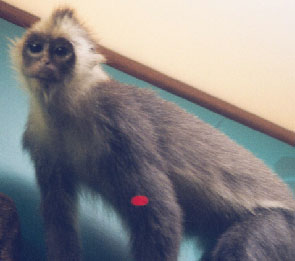The incisors are narrow and the molars have sharp, high crests (Oates and Davies, 1994). This species has a dental formula of 2:1:2:3 on both the upper and lower jaws (Ankel-Simons, 2000). The jaw is deep and the face is short and broad (Oates and Davies, 1994). The pollex (thumb) is reduced in this species (Davies, 1991). The orbits are widely spaced and the hindlimbs are longer as compared to the forelimbs (Oates and Davies, 1994). The average body mass for an adult male mitered leaf-monkey is around 5.9 kilograms, and for the female it is around 5.8 kilograms (Rowe, 1996). This species has a sacculated stomach to assist in the breakdown of cellulose. Infants have a white pelage color with a dark stripe down the back and across the shoulders (Rowe, 1996).
This species has four subspecies each having their own pelage coloration:
